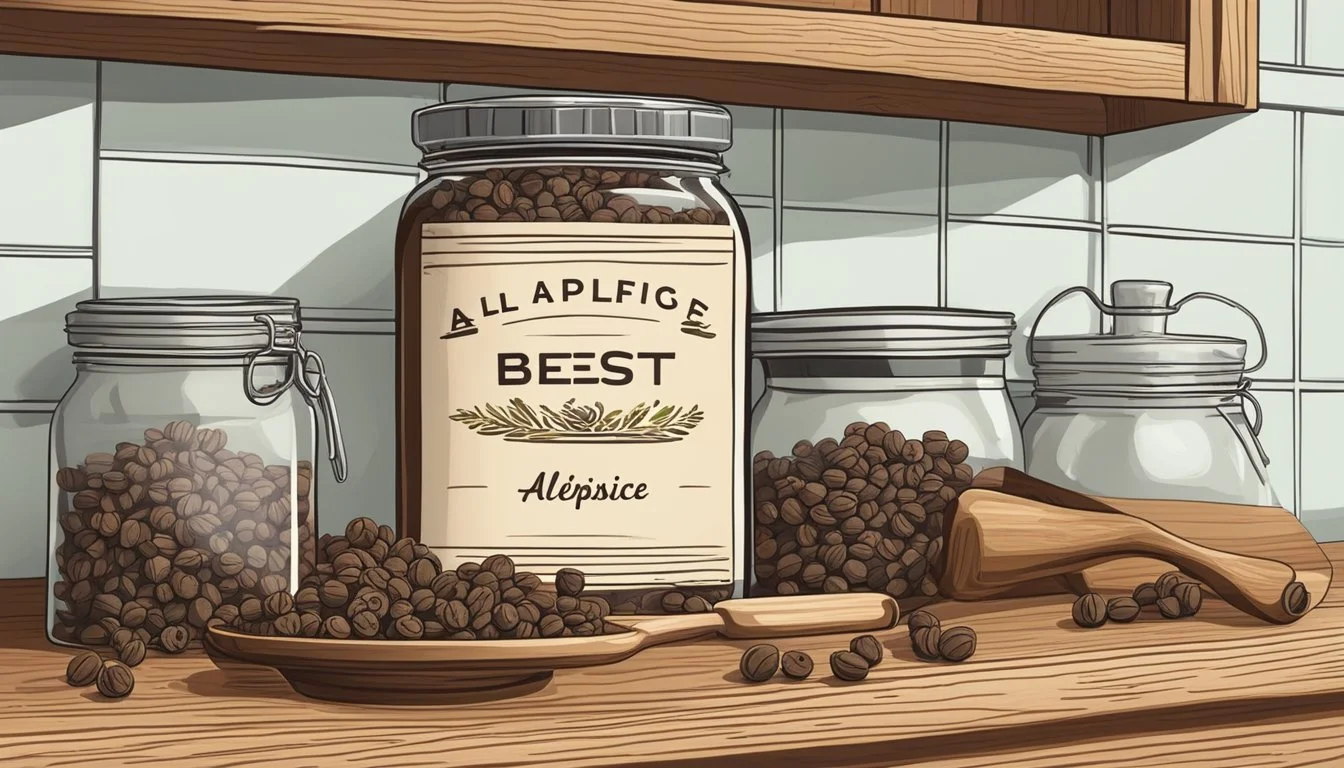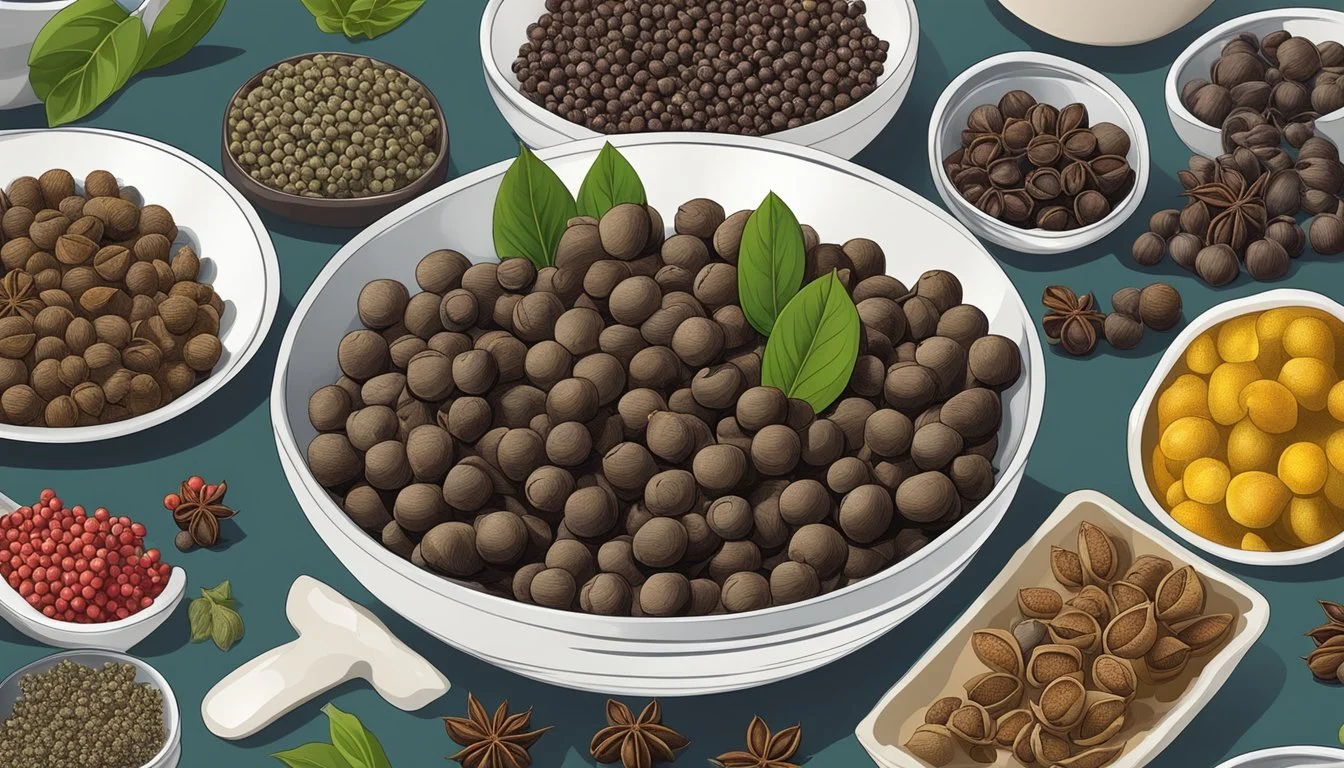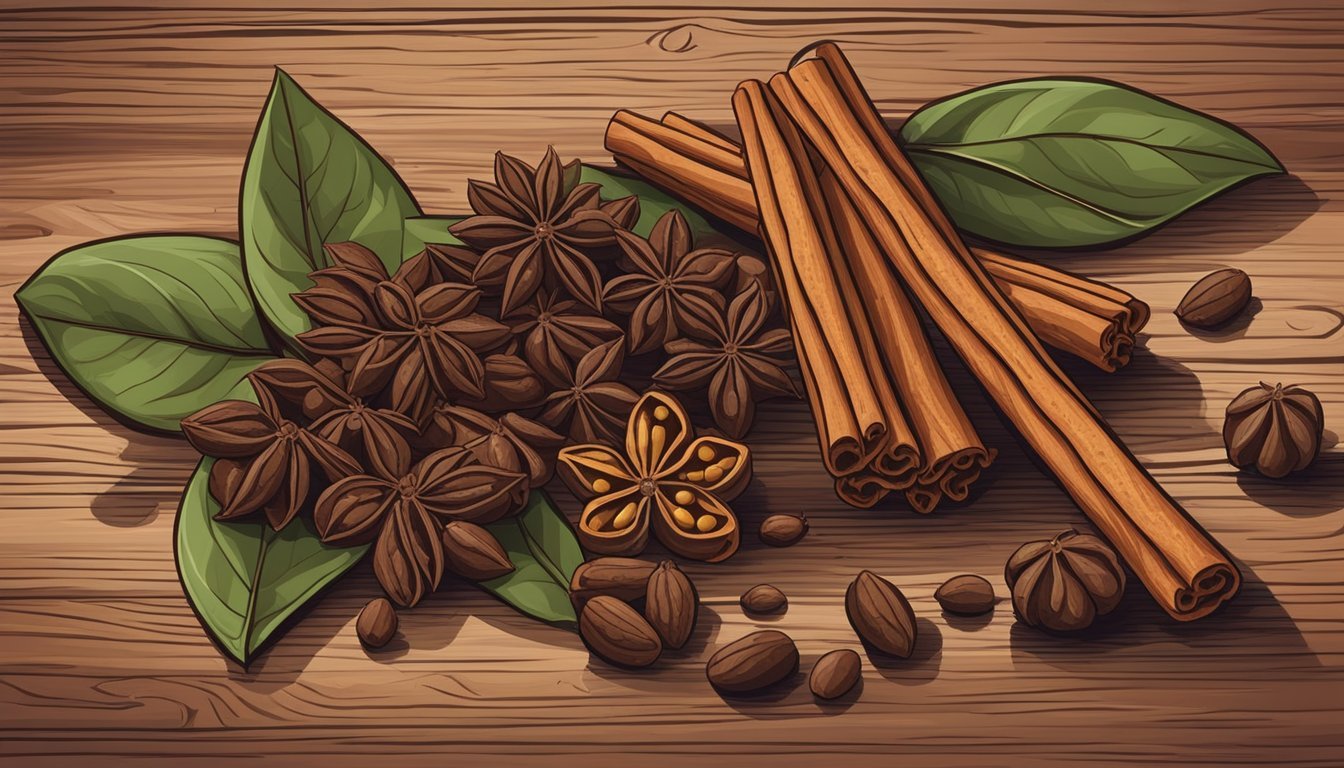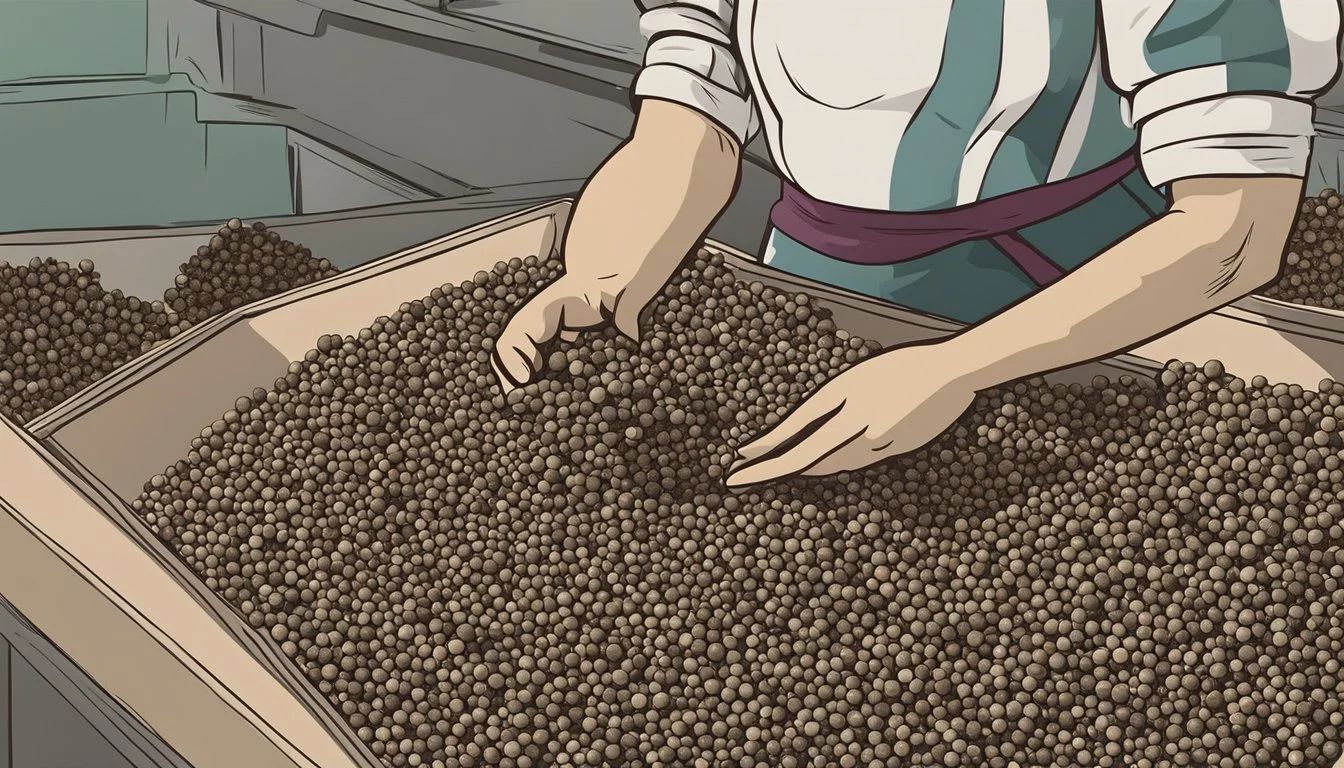How Long Do Allspice Berries Last?
Shelf Life and Storage Tips
Allspice, derived from the Pimenta dioica plant, is a renowned spice that plays an integral role in various culinary traditions. As a member of the Myrtle family (Myrtaceae), allspice offers a flavor that is reminiscent of cloves (how long do cloves last?), cinnamon, and nutmeg (how long does nutmeg last?), which makes it a unique addition to both sweet and savory dishes. Allspice is commonly available in whole berry form, which, when stored properly, can retain freshness and potency for an appreciable length of time.
The shelf life of allspice berries is contingent upon how they are processed and stored. Whole allspice berries, when kept in a cool, dry place away from sunlight, can last for about three to four years. It's vital to store allspice in airtight containers to help maintain its strong, distinct aroma and prevent it from going bad prematurely.
Identifying the freshness of allspice is straightforward. Fresh allspice berries should appear plump and boast a dark brown color. If berries are found to be shriveled or have taken on a gray hue, this suggests that they have lost their vigor, rendering them less suitable for cooking. Additionally, the aroma should be vivid and pungent; a weak aroma can indicate that the berries have started to lose their flavor and should be replaced to ensure the best culinary results.
Allspice Basics
Allspice berries offer a complex flavor profile that is highly valued in various cuisines globally. This section delves into the botanical origins, culinary utility, and distinctive taste of allspice.
Botanical Background
Pimenta dioica, commonly known as allspice, originates from the Caribbean, Mexico, and Central America. Often referred to as Jamaica pepper, this tropical evergreen tree's dried berries are known for their resemblance to peppercorns. Allspice is integral to the culinary traditions of the West Indies and has been adopted by many cultures for its unique flavor.
Culinary Uses
Allspice is versatile and crucial in both sweet and savory dishes. It features in various cuisines as a standalone spice or as part of spice blends, imparting warmth and complexity to stews (What wine goes well with stews?), soups, and marinades. It holds a special place in Jamaican cooking, often being used in jerk seasoning (how long does jerk seasoning last?), and is also popular in pickling and brining.
Flavor Profile
The flavor of allspice is robust and multifaceted, suggesting a blend of cinnamon, nutmeg, and cloves. This profile makes it a singular spice that can both complement sweet desserts and enhance the savory richness of meat dishes. Its pungency is most potent when in whole berry form, with ground allspice tending to lose its intensity relatively quickly.
Storing Allspice
Effective storage of allspice is crucial for maintaining its flavor and longevity. Both whole berries and ground allspice require specific conditions to ensure they remain potent and useful for culinary purposes.
Whole Berries Storage
Whole allspice berries retain their quality for approximately 3 to 4 years when stored properly. The key to longevity is:
Containers: Utilize airtight containers with tight-fitting lids.
Temperature: Keep the berries in a cool area, away from direct heat sources.
Whole berries are less exposed to air and contain oils that degrade slower than ground spices, thus holding onto their flavor for a longer time.
Ground Allspice Storage
Ground allspice loses its pungency more rapidly due to a greater surface area exposed to air. To preserve its potency:
Shelf Life: Expect ground allspice to have a shorter lifespan compared to whole berries.
Sealing: Store in airtight containers immediately after use to minimize exposure to air.
Since ground allspice is more susceptible to flavor loss, it should be used within six months to a year for best results.
Optimal Storage Conditions
For both whole and ground allspice, the following conditions apply:
Sunlight: Store away from sunlight, as UV rays can degrade the quality.
Moisture: Avoid any damp areas, as moisture can lead to spoilage.
Placement: Choose a section of the pantry or cupboard that is not exposed to frequent temperature changes.
By adhering to these storage guidelines, the allspice, whether ripe berries or dried and ground, will maintain its aromatic and flavor profile, extending its usability in a multitude of dishes.
Shelf Life and Quality
Allspice berries, when properly stored, maintain optimal quality for approximately three to four years. The volatile essential oils within the berries contribute to their robust flavor and aroma, which are key indicators of their freshness and quality.
Determining Freshness
Color: Fresh allspice berries have a rich, brown hue.
Surface texture: They should be free from moisture and have a slightly wrinkled appearance.
Aroma: One should notice a strong, pungent scent.
Flavor: A warm, aromatic taste is characteristic of fresh allspice.
Signs of Spoilage
Odor: An absence of the characteristic spice aroma may indicate the berries are past their prime.
Taste: A noticeable lack of flavor or a change in the expected spicy profile can suggest spoilage.
Texture: Berries that are damp or have a moldy exterior are no longer suitable for consumption.
Appearance: Any visible signs of mold or decay on the berries are clear indicators they have gone bad.
Culinary Applications
Allspice is a versatile spice that enhances a wide variety of dishes with its rich flavor profile. It is an essential ingredient in both sweet and savory recipes, offering a unique blend of aromatic warmth.
Baking and Sweets
In baking, allspice is commonly used to add depth and complexity to sweets. For example:
Cookies and Cakes: A teaspoon of ground allspice can transform baked goods with its robust flavor.
Pies and Pastries: Incorporating allspice into fruit fillings, like those for apple or pumpkin pies, gives a warm, autumnal essence.
Savory Dishes
Allspice's versatility shines in savory cooking. Its application includes:
Meats: A touch of ground allspice enhances the taste of beef or lamb dishes.
Stews and Sauces: Incorporating whole allspice berries into stews or tomato-based sauces (What wine goes well with tomato-based sauces?) imparts a subtle, peppery note.
Beverages and Marinades
The spice's aromatic qualities make it ideal for:
Marinades: A dash of allspice in marinades for chicken or pork imbues the meat with a rich, aromatic flavor before cooking.
Beverages: Steeping whole berries can add a nuanced taste to ciders and mulled wine, perfect for colder seasons.
Comparison with Other Spices
In the realm of spices, allspice is often compared to cinnamon, nutmeg, and clove due to their overlapping flavor profiles, which include warm, sweet, and spicy notes. Understanding their shelf life and substitutability can enhance culinary applications.
Allspice vs. Cinnamon
Shelf Life:
Allspice: Whole allspice berries maintain their potency for up to 2 years when stored in a cool, dark location. Grind them only when necessary to preserve the flavor.
Cinnamon: Both ground cinnamon and cinnamon sticks (how long do cinnamon sticks last?) can last up to 2 years, but sticks often retain aromatic oils longer, offering sustained flavor.
Flavor Profile:
Allspice imparts a blend reminiscent of cinnamon, nutmeg, and clove with peppery undertones.
Cinnamon provides a sweet and woody flavor, often more singular in its warming characteristic.
Substitute:
Ground cinnamon can be used as a substitute for ground allspice in many recipes, although it lacks the complex pepper notes.
Allspice vs. Nutmeg
Shelf Life:
Allspice: Whole berries, 2 years for optimal flavor.
Nutmeg: Whole nutmeg can last 2 to 3 years, while ground nutmeg usually should be used within a year for best taste.
Flavor Profile:
Allspice has a multifaceted profile, which includes a hint of the sweet and nutty notes characteristic of nutmeg.
Nutmeg itself is sweeter and more delicate than allspice, with earthy notes and less of the peppery kick.
Substitute:
Ground nutmeg, in smaller quantities, can serve as a subtler substitute for ground allspice.
Allspice vs. Clove
Shelf Life:
Allspice: Retains quality for up to 2 years when stored properly in whole form.
Clove: Whole cloves can also last up to 2 years; however, ground clove loses its potent pungency more quickly, typically within a year.
Flavor Profile:
While allspice encompasses hints of clove’s strong, pungent flavor, it is milder and combines additional notes similar to cinnamon and nutmeg.
Clove possesses a very specific, intense spicy flavor which can overpower the balance achieved by allspice if substituted 1:1.
Substitute:
Ground clove can be a substitute for ground allspice but should be used sparingly due to its stronger, more astringent taste.
Nutritional and Health Aspects
Allspice berries, rich in nutritional value and health benefits, pack a substantial punch when it comes to dietary and medicinal contributions. These berries offer a range of plant compounds, including eugenol, which plays a central role in their health-promoting properties.
Dietary Benefits
Allspice provides a meaningful addition to diets due to its content of vitamins, minerals, and fibers. Its most notable components include:
Vitamins: A modest contributor to the daily intake of vitamins such as vitamin A, vitamin C, and niacin.
Minerals: It includes essential minerals like potassium, magnesium, iron, and calcium.
Fibers: A source of dietary fiber, allspice can support digestive health.
Furthermore, this spice has antioxidant properties that help combat oxidative stress in the body.
Medicinal Properties
The medicinal properties of allspice are largely attributed to eugenol, a plant compound found in the berries. Eugenol is known for its:
Antiseptic qualities: May help with dental hygiene and reduce toothache.
Anti-inflammatory effects: Potentially easing muscle pains and digestive disorders.
Additionally, other plant compounds present in allspice, such as quercetin and gallic acid, contribute to its health benefits by displaying anti-viral and anti-fungal activities. However, while promising, these benefits should be viewed as complementary to conventional treatments and not standalone remedies.
Allspice in Different Cultures
Allspice has been a significant spice in various cuisines around the world, prized for its warm, complex flavor that resembles a combination of cinnamon, cloves, and nutmeg. This section explores the cultural importance and use of allspice in Caribbean cuisine, its influences in Middle Eastern dishes, and its traditional applications in European cooking.
Caribbean Cuisine
In the Caribbean, allspice is more than just a seasoning; it's a cornerstone of the region's culinary identity. Jamaica, in particular, is renowned for its allspice production, where the spice is known locally as "pimento." It is a key ingredient in the famous Jamaican jerk seasoning, where it's often paired with chilies, thyme, and other spices to marinate meats that are then smoked or grilled over pimento wood, enhancing the allspice flavor.
Key Caribbean Dishes with Allspice:
Jerk chicken or pork
Pimento dram (a type of liqueur)
Various stews and marinades
Middle Eastern Influences
Allspice has also left its mark on Middle Eastern cuisine, where it's used to add depth and warmth to an array of dishes. Often found in spice blends such as Baharat, allspice complements the flavors of cumin, coriander, and other regional spices. The berry is also an essential component in meat dishes, rice pilafs, and even some dessert recipes.
Distinctive Middle Eastern Spices with Allspice:
Kibbeh (a Levantine dish often featuring minced meat with allspice)
Meat rubs and marinades
Sweet treats like ma'amoul (cookies filled with dates and nuts (how long do nuts last?)
European Uses
In Europe, allspice has been embraced since its introduction in the 16th century, where it was initially used to flavor food and in medicine. It features prominently in British, Scandinavian, and Eastern European recipes, often used in pies, sausages, and seasonal beverages. Its inclusion in mulled wine and spiced cakes during the festive season is especially notable.
Prominent European Dishes Featuring Allspice:
British corned beef
Scandinavian pickled herring
Eastern European soups and stews
Related Ingredients
In the realm of cooking, allspice berries share a culinary kinship with a variety of aromatic spices and diverse herb and spice blends. These ingredients can either complement or substitute allspice in different recipes.
Other Aromatic Spices
Ginger: Available in both powdered and whole forms, ginger brings a warm, spicy kick that is both distinct and versatile in sweet and savory dishes.
Juniper: Often found in whole berries, juniper offers a pine-like, resinous flavor suitable for meats and spirits.
Fennel (how long does fennel last?): With a slight anise taste, fennel seeds, (how long do fennel seeds last?) both ground and whole, blend well in spice mixes and often accompany pickling recipes.
Caraway Seeds (how long do caraway seeds last?): These seeds provide a sharp, earthy flavor that can add depth to breads, stews, and sausages.
Herbs and Spice Blends
Herbs: Dried herbs (how long do dried herbs last?) such as thyme and oregano present savory notes that enhance many of the same dishes as allspice.
Garlic Powder: (how long does garlic powder last?) Though not a direct substitute, garlic powder imparts a pungent, savory element that supports the complexity within spice blends.
Lemon: Zest or dried lemon peel can contribute a bright, citrus note to balance the heavier, warm flavors of spice mixes.
Pickling Spice (how long does pickling spice last?): Typically, a blend that includes allspice, along with other components like mustard seeds (how long do mustard seeds last?) and bay leaves, it's essential for creating the brines that preserve and flavor pickled goods.
Mincemeat: A festive mix that often contains allspice and other spices like cinnamon and nutmeg to achieve its rich, complex flavor profile often seen in holiday dishes.
Allspice Handling and Processing
Ensuring the quality of allspice requires careful handling and processing from the moment of harvest to its final stage as a ready-to-use spice in the market.
From Harvest to Market
Allspice berries are harvested from mature trees, which are typically 5 to 10 years old. The harvesting takes place when the berries are fully ripe, which occurs in late summer to early fall. It's crucial that the berries are picked at the optimal time to retain their distinctive flavor and aroma. Post-harvest, the whole allspice berries are carefully inspected to remove any that are damaged or diseased, a vital step to maintaining the quality of the spice. Afterwards, they are dried, a process that prevents spoilage and extends shelf life.
Grinding and Packaging
Once dried, whole allspice berries can be sold as is, or further processed by grinding. Grinding converts the whole berries into a fine powder. For the best quality ground allspice:
Grind on-demand, as ground allspice loses its potency more quickly than whole berries.
Packaging should be airtight to prevent moisture and contaminants from affecting the quality.
Storage must be in a cool, dark place to further ensure the spice's flavor remains robust.
Whole allspice berries have a significantly longer shelf life, lasting about 3 to 4 years when stored properly in tightly-sealed containers.
Substitutes and Alternatives
When allspice berries are unavailable, a cook has a variety of options for substitutes that can mimic its warm, spicy, and sweet flavor profile, especially in baking and savory cooking.
In Baking
In baking, the flavor of allspice is often integral to the recipe. Cinnamon, nutmeg, and cloves can be used separately or in combination to achieve a taste that resembles allspice. For instance:
Cinnamon provides a warm and sweet flavor similar to allspice and is readily available in most kitchens.
Nutmeg adds a sweet, nutty tone that complements many baked goods.
Cloves, while more pungent, can be used sparingly to impart a strong spicy note.
A common mix to replace one teaspoon of allspice is:
1/2 tsp of cinnamon
1/4 tsp of nutmeg
1/4 tsp of clove
In Savory Cooking
Savory dishes that call for allspice may benefit from a careful blend of the same spices used in baking, as they also contribute to the complexity and depth of the dish's flavor:
Cinnamon can add warmth and sweetness to savory dishes, but should be used conservatively to avoid overpowering other flavors.
Nutmeg offers a subtle spiciness which works well in creamy sauces and soups.
Cloves must be used judiciously in savory dishes due to their strong flavor which can dominate the dish if overused.
For cooking, if the recipe calls for one teaspoon of allspice, the following ratio is a good starting point:
1/2 tsp of cinnamon
1/4 tsp of nutmeg
1/4 tsp of clove
The spices should be adjusted according to taste and the specific requirements of the recipe.
Tips for Cooking with Allspice
Allspice is a versatile seasoning known for its rich flavor that combines hints of nutmeg, cinnamon, and clove. When cooking with allspice, one should employ strategies for balancing its potent flavor and understand how to effectively incorporate it into various recipes.
Balancing Flavors
Mild Dishes (What wine goes well with mild dishes?): For dishes with mild ingredients such as cabbage, a pinch of ground allspice can add a warm, aromatic depth.
Rich Sauces and Stocks: When enriching stocks or sauces, allspice berries impart a subtle complexity. It is advisable to start with a single berry, taste, and adjust accordingly.
Sweet vs Savory: In sweet dishes, allspice's naturally sweet undertones enhance the flavor profile. In savory dishes, its peppery notes provide a grounding balance.
Using in Recipes
Whole Berries: Allspice berries can be added to stocks or stews, infusing the liquid with flavor as they simmer. One should remove the berries before serving.
Quantity Suggested Use 1-2 Soups and small batches of stock 3-4 Larger pots of stew or brining solutions
Ground Allspice: Ground allspice is more concentrated and should be used sparingly. Half a teaspoon can season an entire pot of stew.
Recipe Suggested Amount of Ground Allspice Single pie 1/4 tsp Medium-sized pot of stew 1/2 tsp
When cooking with allspice, one must be cautious to avoid overpowering other flavors, remembering that a little goes a long way.











